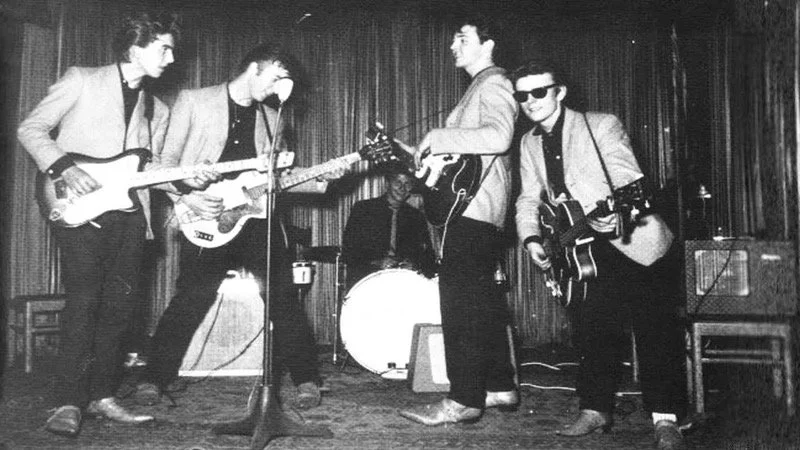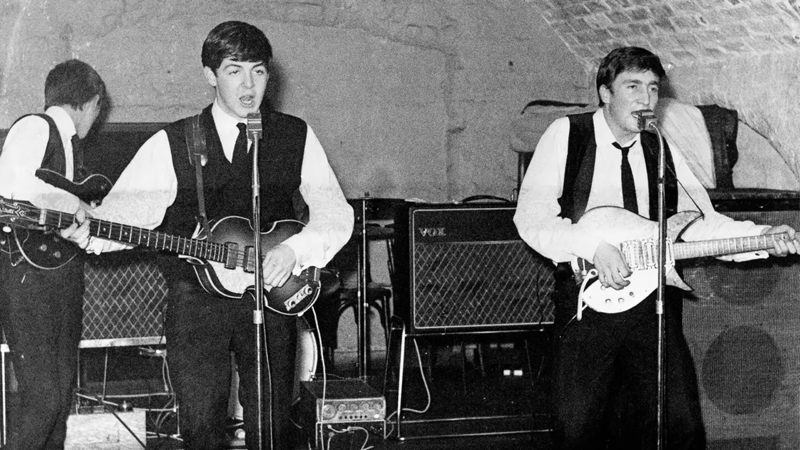The Story Of Paul McCartney's Lost Bass
Image Source: Entertainment Weekly
Recently, Sir Paul McCartney, most famous for being the bassist and one of the primary songwriters for The Beatles, has been reunited with his first Höfner 500/1 Violin Bass. However, what is the significance of this find, and how did it get lost in the first place? Let's go on a “Magical Mystery Tour” through Beatles history and follow the journey of this bass from The Beatles’ days in Hamburg to now.
The Ever-changing Bassists And Names Of The Beatles
Before we discuss the iconic bass, let’s first briefly discuss how Paul McCartney switched into the bassist role. McCartney joined The Quarrymen as a guitarist. George Harrison joined the band a year later. By 1959, John Lennon, Paul McCartney, and George Harrison were the only three remaining members of the original group, with the other members having left due to the band going in a more rock and roll direction rather than the group’s original skiffle. They were doing well as a guitar group, but needed something to give them the extra drive to sound like the bands in America at the time, and that something was either a drummer or a bass player.
RELATED:
Image Source: YouTube
Considering they struggled to get a consistent drummer at the time, they went with the latter. John recommended his art school friend, Stuart Sutcliffe. Sutcliffe bought a Höfner President bass with the money he got from selling one of his paintings. Sutcliffe was soon joined by drummer Pete Best, and after playing at various venues under various names such as Long John and The Silver Beetles, The Silver Beetles, and The Silver Beatles, they went to play in Germany, now under the name “The Beatles.” The residencies at both the Kaiserkeller and rival Top 10 Club went well…despite John, George, and Paul getting deported for various reasons (damages to property or being underage).
Sutcliffe, however, decided to stay in Germany with his girlfriend, Astrid Kirchherr. Chas Newby, a bandmate of Best’s from The Black Jacks, briefly sat in on bass, but the role was soon handed to McCartney temporarily before Sutcliffe came back to Liverpool and rejoined the band for their shows at The Cavern Club and their second Germany residency. Sutcliffe was noticeably lacking in his commitment to the group (which enraged McCartney to the point of erupting into a full-blown confrontation with Sutcliffe) and decided to leave the group and stay in Germany.
Image Source: The Guardian
McCartney: Reluctant Bass Player With An Iconic Bass
McCartney reluctantly became the band’s permanent bass player. The bass was not a very popular instrument, and he stated that it was “the thing that the fat boys got lumbered with and were asked to stand at the back and play.” He initially borrowed Sutcliffe’s Höfner President bass. He kept this bass until he could afford another bass that was more suited to a southpaw such as himself. During another residency in Germany, Paul visited the Steinway-Haus music shop, and there it was: a bass that seemed perfect for McCartney. It was a symmetrical bass that resembled a violin. Paul McCartney recounted the encounter as such:
“I remember going along there, and there was this bass which was quite cheap. I couldn’t afford a Fender. Fenders even then seemed to be about £100. All I could really afford was about £30…so for about £30 I found this Hofner (500/1) violin bass. And to me it seemed like, because I was left-handed, it looked less daft because it was symmetrical. Didn’t look as bad as a cutaway which was the wrong way.”
They didn’t have a lefthanded bass available, so McCartney had it custom-ordered. That 1961 Höfner 500/1 Violin Bass would be used on a huge amount of early Beatles recordings, such as “Twist and Shout,” “Love Me Do,” and “Please Please Me.” In 1963, McCartney got another Höfner 500/1 Violin Bass, and the 1961 bass was relegated to a backup bass. The 61 bass needed several repairs over the years and received an overhaul in 1964.
Image Source: YouTube
McCartney would use the 63 bass on all Beatles recordings until he received the Rickenback 4001 in 1965, and that would be his main driver for the rest of The Beatles’ recording career, with him occasionally switching to either the 61 or 63 Höfner. The 61 bass would make an appearance in the promo film for “Revolution” (pictured above), but it is unclear if he used that bass on the song. Its last film appearance would be during the “Get Back” sessions in 1969, and it was thought that it was stolen from Twickenham Studios. However, though the bass was stolen, it was a little later than 1969 and after The Beatles had disbanded
Image Source: Beatles Blog
The Iconic Bass Is Lost
It was on October 10th, 1972, that the 1961 bass was stolen. The bass was in a van with presumably other gear for Paul’s new band, Wings, in the Notting Hill area of London. During the night, someone absconded with the famous bass and sold it to Ronald Guest, the landlord of the Admiral Blake pub in Ladbroke Grove, London. The bass would remain lost for over 50 years. Lucky for McCartney, however, he still had the 1963 bass, but he still wondered where exactly the 1961 model had run off to. No formal search for the bass was conducted until 2018 when the Lost Bass Project was born.
The Lost Bass Project
The Lost Bass project began in 2018 as a fan campaign to locate and track down Paul’s iconic 1961Höfner. The brainchild of Höfner historian Nick Wass, he was asked by McCartney himself to track down the iconic instrument.
“Paul said to me, ‘Hey, because you’re from Höfner, couldn’t you help find my bass?’” Wass said. “And that’s what sparked this great hunt. Sitting there, seeing what the lost bass means to Paul, I was determined to solve the mystery.”
Though the search gained some traction, it wouldn’t be until journalists Naomi and Scott Jones joined the search that things started heating up. They would soon get more and more leads. Ian Horne, a former sound engineer for McCartney, would contact them and tell them more details about the theft, and after another update, they were contacted by someone who claimed to be a child of the thief, who sold the bass to Ronald Guest for a few pounds and some beers. As more and more updates were published, and those involved in The Lost Bass Project were tracking down relatives of the Guest family, it dawned on one Cathy Guest that the old bass in her attic was actually a piece of rock history.
Image Source: Reuters
The Bass Is Found!
Cathy Guest, the daughter-in-law of Ronald Guest, soon contacted The Lost Bass Project, telling them that she had the bass. It turns out, the bass was passed down to Ron’s eldest son. The eldest son died in a car wreck, and it was then passed down to Haydn Guest. Haydn was married to Cathy, and he passed away in 2020. This was the breakthrough that they needed! The iconic bass was soon authenticated and returned to McCartney, who “was excited as a school boy” to see the instrument after half a century. Though the bass does need some repairs, it is currently “back to where it once belonged” and in McCartney’s possession. Who knows what other missing artifacts may be out there? Check your attics, dear readers!
READ NEXT:
Sources: Guitar World, [1], [2], The Lost Bass Project, Bass Musician, Delta Optimist


















